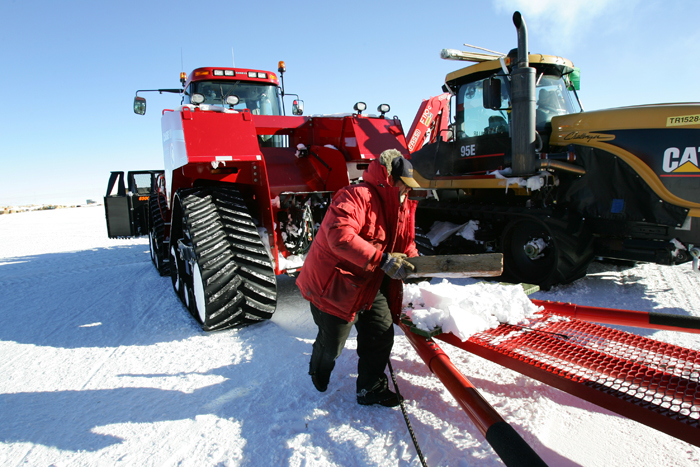|
Ready to rollSouth Pole Traverse re-establishes 1,600-kilometer trail for logistics transport of fuel and materialsPosted February 29, 2008
On the morning of Jan. 13 — as most of the population at Amundsen-Scott South Pole Station slept, weary from the previous day’s dedication of the new research station — the South Pole Traverse tractor train chugged away back to McMurdo Station with little fanfare. Related Story
Science groups also make motorized trips to the South Pole. See story Down at the Crossroads.
It’s a marked contrast to the jubilant scene that took place here about two years ago. That’s when traverse leader John Wright and company ended four long years of trail building to arrive at the South Pole just before Christmas in 2005, proving that it would be possible to deliver fuel and materials reliably between the two U.S. Antarctic Program research stations. (See the Jan. 1, 2006 issue of The Antarctic Sun Those were the days of trailblazing. Now it’s time to put the concept to work after a one-year hiatus. “We pretty much reoccupied the same trail the whole way, except maybe a mile or two, or a couple hundred yards on top of the Leverett [Glacier],” said Paul Thur, South Pole Traverse manager, on the morning of departure from Pole. Thur, like most of this year’s team, is new to the traverse. But their mechanic, Russ Magsig, has been on the project since its inception, traveling on the first 200-kilometer foray from McMurdo Station during the 2002-03 austral summer. “It was softer than I figured,” Magsig said of the snow trail marked by bamboo poles topped with flags. “I thought we would have a little more base on the top. But we came through it OK.” The trail markers were generally in pretty good shape, he added. That means future traverse teams will not have to spend too much time re-flagging the route each season. “Some of those flags are going to last five or six years,” Magsig said. The markers closest to Pole — and the youngest part of the route — appeared as if they just came off the supply ship, Thur added. “They almost look brand new.” This year’s mission was to re-establish the 1,600-kilometer-long route between McMurdo and South Pole stations, conducting maintenance along the way. It took the team 43 days to make the journey, not including time at the front end of the trip filling in crevasses along the shear zone. A mere 5.5-kilometer-long blip early in the route, not far from McMurdo Station on the Ross Ice Shelf, the shear zone is famously Swiss-cheesed with crevasses. Thur said the team filled in 10 medium-size fractures (compared to the previously filled ones), and would need to keep an eye on about a dozen more features. “The shear zone was kind of rewarding because we’ve been able to maintain that same road for … six years,” Magsig said. “If we make a new road [through the shear zone], that would be five years of usage that we could get out of it.” The National Science Foundation wants to use the traverse as an alternative way to deliver fuel, as well as bulky materials, to the South Pole. Currently, the ski-equipped LC-130 aircraft operated by the New York Air National Guard is the only means of such transport. And the traverse tractors and their sleds wouldn’t return to McMurdo empty, as they could haul back waste and obsolete materials. This year was more of a practice run for Thur’s team. They delivered a little more than 8,000 gallons of fuel in large bladders. “[We] proved that you can bring bladders all the way to the Pole once the trail is remediated,” he said. The goal is to haul as much as 200,000 gallons of fuel across the continent eventually. “That’s years down the road,” Thur noted. Magsig added, “We’ve got to work up to that.” |
"News about the USAP, the Ice, and the People"



For USAP Participants |
For The Public |
For Researchers and EducatorsContact UsU.S. National Science FoundationOffice of Polar Programs Geosciences Directorate 2415 Eisenhower Avenue, Suite W7100 Alexandria, VA 22314 Sign up for the NSF Office of Polar Programs newsletter and events. Feedback Form |


